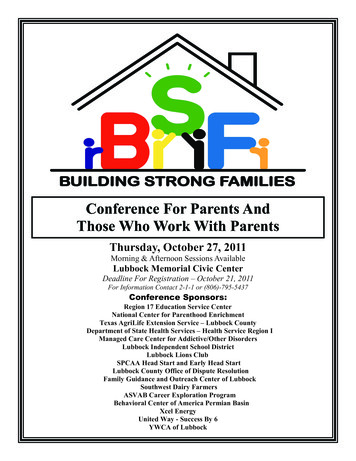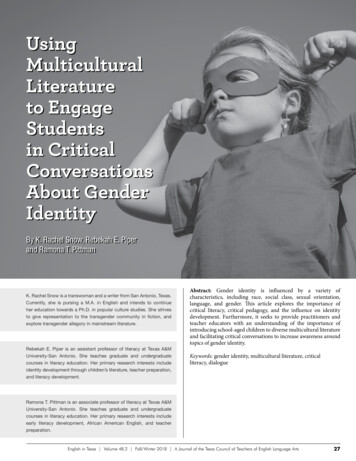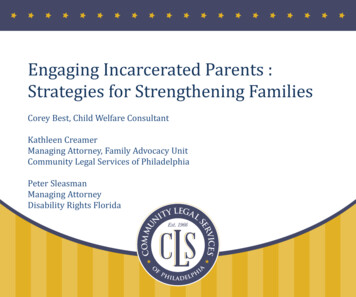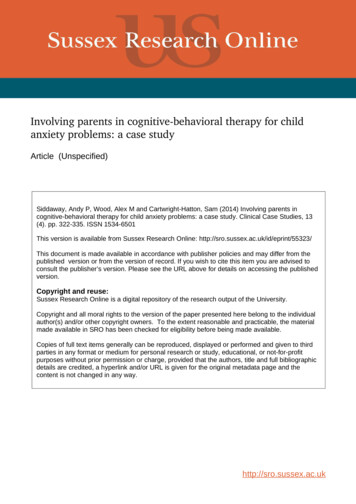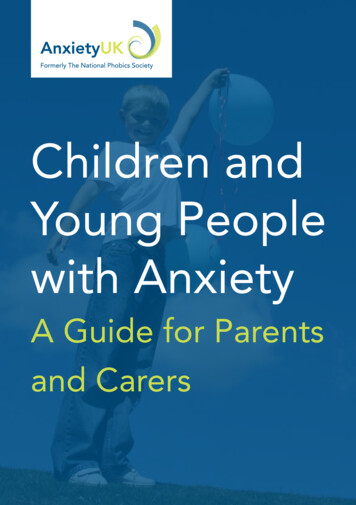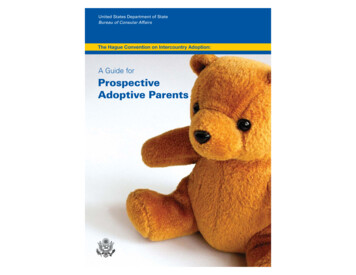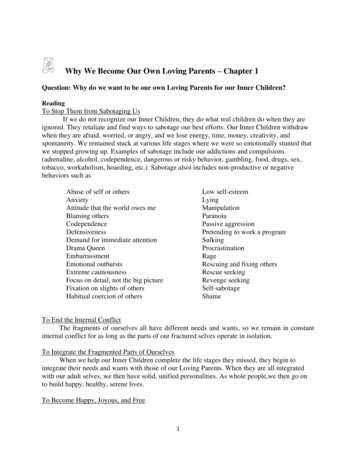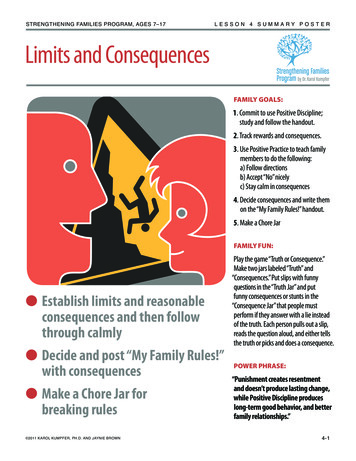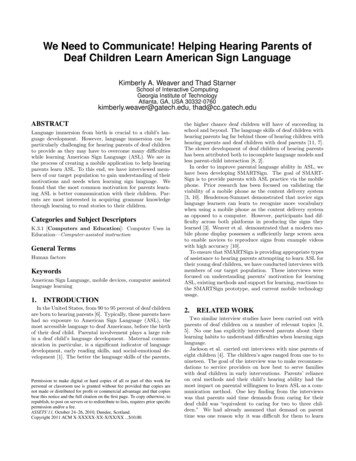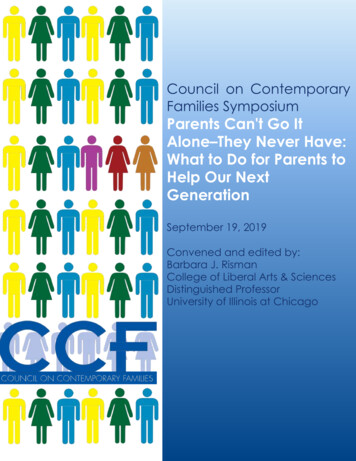
Transcription
Council on ContemporaryFamilies SymposiumParents Can't Go ItAlone–They Never Have:What to Do for Parents toHelp Our NextGenerationSeptember 19, 2019Convened and edited by:Barbara J. RismanCollege of Liberal Arts & SciencesDistinguished ProfessorUniversity of Illinois at Chicago
Council on Contemporary Families Symposium: Parent's Can't Go It Alone2CCF Symposium: Parents Can't Go It AloneTable of ContentsEXECUTIVE SUMMARY: Children Are Now Back at School, Time to3Focus on What Their Parents NeedBarbara J. RismanWhy No One Can “Have It All” and What to Do About It6Kathleen GersonWork that Works for Low-Wage Workers10Maureen Perry-JenkinsFears of Violence: Concerns of Middle-Class Latinx Parents13Lorena GarciaMothering While Black16Dawn Marie DowDads Count Too: Family-Friendly Policies Must Include Fathers18Stephanie CoontzRaising a Village: Identifying Social Supports for All Kinds of Families21Caitlyn CollinsFURTHER INFORMATION & CONTACT25
Council on Contemporary Families Symposium: Parent's Can't Go It Alone3Executive Summary: Parents Can’t Go It Alone—They Never Have:What to Do for Parents to Help Our Next Generation.*Executive summary prepared for CCF by Barbara J. Risman, College of Liberal Arts &Sciences Distinguished Professor, University of Illinois at Chicago.Children Are Now Back at School, Time to Focus on What Their Parents NeedThe birth rate is falling throughout much of the world. Yet many people still want to be parents,and they invest great time, energy and love in their children. The essays in this symposium offerresearch evidence on the state of parenting among a diverse group of American parents. Eachessay suggests possibilities for how our society might come to the aid of today’s parents.Kathleen Gerson busts the myth that there is such a thing as “having it all.” On the basis ofinterviews with 120 young adults (33–47 years old), she found four basic patterns for managingthe conflicts between the world of work and raising children. Some are hyper-traditional, withmen in very time-consuming jobs and women without paid work doing intensive mothering.Others opt out of the dilemma of balancing work and family problems by remaining single orchildless. Another pattern Gerson found was in families where women “do it all” rather thanhave it all. In these families, both mothers and fathers work for pay, but mothers continue to dothe primary parenting. Finally, about one-third of the people she talked to can be described asegalitarians, experimenting with building an equal partnership despite the obstacles. Only theegalitarians prefer the choice they have made; most of the others would prefer egalitarianrelationships, but have not found a way to achieve them in a society that demands more fromworkers than ever before, and with a philosophy of childrearing that requires intensive attention.Gerson suggests that it’s time to change the workplace, so that families can live the lives theydesire.Maureen Perry-Jenkins offers some concrete suggestions for what needs to change so that lowwage workers can meet their families’ needs. In interviews with 360 low-income workingfamilies, a shortage of time was a recurring theme. Parents needed time to sleep, care for babies,and connect with their partner, but they also needed predictability in their schedules. Controlover time makes it possible to have last-minute doctor appointments or a needed sick day. Jobsneed to have predictable schedules. But beyond that, workers talk about the benefits of autonomyand the ability to get respect for taking initiatives at work. Conditions at work affect parents’mental health and their relationships with their children and partners. Perry-Jenkins suggests thatto support today’s families we must to improve workplaces and build cultures of respect andsupport. One way to support the next generation is to pay attention to the conditions of work fortheir parents. Work matters.In the next essay, Lorena Garcia argues that the world around us matters a great deal for ourfamilies. Garcia interviewed 68 middle- and upper-middle-class Latinx parents in theChicagoland area. What she found was both optimism and worry. The parents were optimisticthat they had the knowledge and financial resources to help their children pursue their dreams.
Council on Contemporary Families Symposium: Parent's Can't Go It Alone4Yet they worried, especially about their sons. They worried about the vulnerability of Black andLatino boys to gun violence in the city. Even though most did not live in high-crimeneighborhoods, they worried about gang-related violence and violence at the hands of the police.They gave their sons a version of “the talk,” trying to help them reduce their vulnerability topolice racism. Garcia reminds us that all parents are concerned for their children’s safety, butthat particular worries vary by race and class. Despite economic privileges, the Latinx parents inher study had serious concerns about their sons’ physical safety. No parent should have to go towork worried about their children’s safety. Garcia shows us that good family policy must includereducing gang-violence and police racism.Dawn Dow offers a view of African-American mothering that is at odds with the presumptionthat all mothers similarly feel a conflict between paid work and parenting. In interviews withmiddle- and upper-middle-class African-American mothers, Dow found that working for pay isconsidered part of a mother’s responsibility—that financial support for children is part ofmothering work. Indeed, stay-at-home mothers are more likely to have to explain their choicethan are those in the labor force. What sets these mothers apart from how other Americanmothers talk about parenting is that they felt supported by their families and communities fortheir paid labor. They have often been raised in a household with two incomes and lived incommunities where a woman's strength and independence are seen as virtues. Their families andcommunities provide emotional and instrumental support for employed mothers. Dow’s researchreminds us that not only must we change the structures of workplaces to support parenting, butwe must support cultural expectations and communities that validate parents’ ability to combineearning a living with caring for others.Although some of the essays in this symposium are all about mothering, Stephanie Coontzreminds us that dads count too. She suggests that a major obstacle to the successful coordinationof work and family life is the assumption that the problem belongs only to mothers. If fatherswere not presumed to be entitled to focus solely on earning a living, mothers would never bepresumed to have to do it all. A historian, Coontz reminds us that this exemption of fathers fromthe demands of family life is not traditional at all. For millennia, fathers and mothers shared theduties of making sure everyone ate and supervising the children. Coontz provides data on thekinds of parental leave available to fathers, and shows the inequity of providing more or betterleave to mothers. Coontz suggests, however, that when paternal leave taking becomes morenormative, as in Denmark, it can lower the motherhood penalty in wages and increase householdwages. Indeed, fathers who take parental leave raise more egalitarian sons. This suggests thatfeminists must work as strenuously for fair and generous paternal leaves as we do for maternalleaves.In the final essay of the Symposium, Caitlyn Collins takes us on a deep dive into the socialpolicy that makes it easier or harder to be an employed parent. She interviewed 135 middle-classworking mothers in Sweden, Germany, Italy, and the United States. The European countrieshave quite different social policies, but all have more family-related policies than does theUnited States, so employed mothering is less stressful in those countries than in the UnitedStates. The kinds of job protections that matter include parental leave for caretaking, maternityleave surrounding childbirth itself, paid vacations and holidays, mandatory sick days, andavailable and affordable child care. Collins ends by suggesting that the lack of policies in the
Council on Contemporary Families Symposium: Parent's Can't Go It Alone5United States sends the message that our families are on our own—that the community owesnothing to those raising the next generation of citizens. The United States lags behind othersocieties and is exceptional for the lack of support for family life.The essays in this symposium show why parents cannot do it alone, and why they should nothave to. It is time to focus on what parents need from the rest of us to successfully raise the nextgeneration. These essays suggest that parents need workplace policies that presume all workersare also caretakers at some point in their lives. Every child deserves a parent whose work doesnot challenge their mental health, a parent who can be effective at work while also providingcaretaking, and neighborhoods that are safe. These essays show that the family policies we needinclude parental leave and workplace flexibility, but those alone are not sufficient. Reducing gunviolence, reducing racism and its effects, and creating workplaces where employees feelrespected are also among social policies needed to support American parents and their families.are also among social policies needed to support American parents and their families.
Council on Contemporary Families Symposium: Parent's Can't Go It Alone6Why No One Can “Have It All” and What to Do About ItA briefing paper prepared by Kathleen Gerson, New York University, for the Council onContemporary Families’ Symposium Parents Can’t Go It Alone—They Never Have.If debates about women’s rights, relationships between the sexes, and worsening conflictsbetween paid work and family life seem endless, that’s because Americans can’t agree on what ishappening, much less on what to do about it. Some blame the problems on a “gender stall,” aswomen continue to hit glass ceilings at work and perform the lion’s share of caregiving at home.Others focus on the decline of men’s breadwinning as their earnings erode, their labor forceparticipation drops, and they fall behind women in educational attainment and career aspirations.Progressives lament the lingering traditionalism that leaves women mired in second-classcitizenship, while conservatives worry about the rise of a self-centered individualism thatelevates personal freedom over lasting commitments to others.To gain a more nuanced picture of how today’s adults are negotiating work–family conflicts, Iconducted face-to-face depth interviews with 120 (self-identified) women and men between theages of 33 and 47 years—the years when most Americans face their peak challenges in buildingboth their work and their family lives. I went to two different geographic areas, interviewingpeople living in the heart of the “new economy” in Silicon Valley (stretching from San Jose tothe East Bay) and those living in or near America’s biggest city, the New York metropolitanarea. This approach yielded a group with diverse racial, economic, and educational backgroundsliving in a variety of family arrangements, including singles, cohabiters, and married couples.My interviews revealed four major patterns of response to the challenges of earning a living andcaring for others. At one end of the spectrum, one-fifth of my participants adopted a “hypertraditional” pattern that emphasized overwork for fathers and intensive parenting for mothers.Concerns about job security prompted husbands to put in very long work weeks (ranging from60 to as many as 100 hours) to assure employers of their work commitment. In a parallel way,concerns about living up to a standard of “intensive parenting” left wives with equally strongpressures to devote their utmost attention to childrearing. Although these mothers and fathers feltoverworked in their separate spheres and deprived of both personal time and time together as acouple, they did not believe they could risk doing anything else.At the other end of the spectrum, 24 percent opted to remain “unencumbered.” These adultsremained single and childless or became estranged from offspring in the wake of a breakup. Acomparable percentage of women and men followed this path, but they did so for differentreasons. The men were typically unable (or unwilling) to find steady work and concluded theycould not afford to take on the financial or emotional responsibilities of marriage andparenthood. The women found they valued work too much to dilute their career commitment bytaking on commitments to care for husbands and children.In a very real sense, the hyper-traditional couples are recreating traditional gender patterns in anespecially extreme form, whereas the unencumbered are opting to preserve their independenceby avoiding such traditional family commitments. Yet together these two extremes account foronly 44 percent of my respondents. The remaining 56 percent comprises two additional groups.
Council on Contemporary Families Symposium: Parent's Can't Go It Alone7About a quarter (26 percent) of my participants are in relationships that reflect the simultaneousdecline of the male breadwinner wage and the persistence of the female caregiver norm. Thesefamilies rely on the woman’s earnings as much as they do on the man’s (and sometimes more)but they also depend on her for the bulk of caregiving. In these cases, women do not “have it all”so much as they “do it all.” It is hardly surprising that carrying the load as both a primary or cobreadwinner and the main caretaker leaves most of these women feeling tired, disheartened, andunappreciated—but they are not alone in their frustration. Most of the men in these relationshipsalso express frustration, saying they wish they could do more caregiving, but fear that taking thenecessary time would endanger their job security and prospects. What’s more, these are notunrealistic fears. Research has demonstrated that a “flexibility stigma” penalizes workers—especially professional men—who choose to pull back even slightly to engage in care work athome.The remaining 30 percent of my participants can be described as egalitarians—couples who areexperimenting with building an equal partnership despite the obstacles. With no clear path tofollow, they do so in varying ways and with varying degrees of success. A third of this group(about 12 percent of the entire sample) decided to avoid the difficulties of equal caretaking byforgoing parenthood altogether, with many looking to relatives, friends, and pets for other formsof caregiving ties. The rest were willing to limit their working time, risk their financialprospects, and forego sleep and personal time to try to divide work and caregiving equally. Yetthe dearth of institutional supports has left many of the work–care egalitarians wondering howlong and at what cost they can sustain their efforts.Despite their differences, all these strategies are responses to a similar set of pressures andconflicts. Rising job insecurity has upped the ante for workers, forcing them to put in long hoursor risk losing their employment or endangering their future security. On the home front,concerns about rising inequality and declining social mobility have upped the ante onchildrearing, creating a sense that only intensive parenting can prepare children to navigate anuncertain future.Each of the four strategies described inevitably produces some degree of dissatisfaction, but theone commonly seen as most challenging—that is, the egalitarian strategy—turns out to be mostpreferred by those who practice it.Figure 1 shows that 55 percent ofhyper-traditional women and 38percent of hyper-traditional menwould prefer a differentarrangement, while 84 percent of thewomen who “do it all” and 75percent of men who rely on a womanto do it all would also prefer adifferent arrangement. Among theunencumbered, 58 percent of womenand 76 percent of men report that adifferent situation would be
Council on Contemporary Families Symposium: Parent's Can't Go It Alone8preferable. In contrast, those expressing the lowest desire for a different arrangement are theegalitarians, with only 7 percent of women and 29 percent of men saying they would prefer oneof the other alternatives.What arrangement do people prefer? Figure 2 shows that in addition to the egalitarians, where 93percent of women and 71 percent of men prefer their situation, most of the rest of myinterviewees also would prefer to share breadwinning and caregiving in an egalitarian way if thatwere a more realistic option. Women are understandably more likely to prefer sharing, with 74percent of those currently “doing it all,” 58 percent of the unencumbered, and 55 percent of thosein hyper-traditional relationships preferring more equal sharing. Although men expressed lessenthusiasm for sharing, asignificant minority—includingnearly a third of hyper-traditionalmen, almost half of men who relyon a woman to do it all, andslightly more than half ofunencumbered men—expressed apreference for an egalitarianpartnership.These findings make it clear thatalthough every work–care strategyposes significant trade-offs anddifficulties, people should not beforced to choose between hypertraditionalism and hyperindividualism. Given the realities of the new economy, which relies on women workers butrarely longer offers job security to anyone, regardless of their gender identity or class position, itis neither humane nor just to confine the measure a man’s worth to his ability to be a successfulbreadwinner or a woman’s worth to her willingness to be a selfless caregiver. The solution is notto shore up and intensify an outdated system, but to address the inequalities and insecurities thatpermeate the current one.How can we get to a more reasonable future? The first step is to reframe the work–care debate. Itis time to jettison the tired lens of “having it all”—a lens that sees earning and caregiving asincompatible goals and the people (read women) who seek it as selfish or unrealistic. Instead, itis time to build our work and caring institutions on the principles of gender justice and work–care integration. Concretely, this means regulating time norms at the workplace so no workermust choose between excessively long work weeks and job insecurity. In our communities, itmeans creating caretaking resources that extend beyond the privatized household for children ofall ages. And in our political institutions, it means ensuring equal economic opportunities forwomen of all stripes, equal caregiving rights for fathers as well as mothers, and a strengthenedsafety net that provides everyone with the basics that fewer and fewer jobs provide, such as alivable income, decent health care, and access to supports for weathering the ups and downs ofour increasingly uncertain economic and family lives.
Council on Contemporary Families Symposium: Parent's Can't Go It Alone9The rise of the new precarious economy is as challenging as the rise of the industrial system wasmore than a century ago. This transformation calls for structural and cultural realignments as vastas the shifts they need to address. Judging from the responses of my informants, the costs ofdoing nothing are far greater than the costs of helping everyone—women and men alike—forge amore balanced, equal, and secure division of work and caregiving.FOR MORE INFORMATION, PLEASE CONTACT:Kathleen Gerson, Professor of Sociology, and Collegiate Professor of Arts and Science at NewYork University, Kathleen.gerson@nyu.edu.
Council on Contemporary Families Symposium: Parent's Can't Go It Alone10Work that Works for Low-Wage WorkersA briefing paper prepared by Maureen Perry-Jenkins, the University of Massachusetts, Amherst,for the Council on Contemporary Families’ Symposium Parents Can’t Go It Alone—They NeverHave.Low-wage jobs may not be anyone’s ideal for acareer, but they are not going away anytime soon.The latest data from the Bureau of Labor Statisticsshown (Figure 1) show that nearly one out of fourAmericans works for low wages. Many areparents. It is critical for the quality of family lifein America that we understand how workingconditions, including hours and flexibility, affectparents’ well-being, the quality of parenting, and,of course, the well-being of American children.What are the problems for family life created byworking conditions at low-wage jobs and what aresome of the solutions to solve them? Tounderstand what about low-wage work hurtsfamilies and what helps, we conducted interviewswith 360 low-income, working families copingwith new parenthood and old jobs.Time was a theme that came up over and overagain in our interviews with new parents. Theytalked about needing time to sleep, work, care forbabies, connect with their partner, or simply to be alone. Parents also needed predictability intheir time, meaning consistent and set hours. Parents with whom I talked also expressed the needfor some control over their time, such as being able to make last-minute doctor appointments ortake a needed sick day.Parents need access to caregiving leaves, sick time, personal time, flexibility, andpredictability—issues currently being addressed by policy initiatives across the country. But theyalso need better conditions of employment. In our efforts to support families by providingflexibility, predictability, and time away from work, we often overlook the impact of whathappens during the 40 hours per week spent “on the job.” Experiences on the factory floor, inthe nursing home, or on food service lines that occur hourly, weekly, monthly, and year afteryear affect workers’ mental health, emotional well-being, physical health, stress, and energy.Such experiences can either enable or disable workers’ abilities to be engaged and sensitiveparents. The question of how we “create” low-wage jobs that provide autonomy, meaning, andsupport requires listening to the workers themselves and understanding what about their workmatters to them.Recent interventions aimed at improving workers’ control over their schedules and enhancingsupervisor support have shown that efforts to provide greater control and autonomy to workers
Council on Contemporary Families Symposium: Parent's Can't Go It Alone11produce better mental and physical health in workers and less employee turnover. But howcontrol and autonomy might look in low-wage jobs is not obvious. My research suggests thatwhat actually matters for low-wage workers is being able to take some initiatives and beingrecognized for doing so. For example, one woman I interviewed, Linda, who worked in a candlepacking factory as an order packer, reported extremely high levels of job autonomy. We learnedthat when she first started packing orders for customers, she would slip in some new candlescents with each order with a note to customers about how they might enjoy this new product.Slowly customers began to specifically request her services. Her boss recognized her creativityand “autonomy” and had her train new workers on how to connect with customers. She feltvalued and respected for her work. Others parents have described autonomy at work as havingtheir opinions valued and having a voice in decision making.Conditions on the job affect workers’ mental health, and that affects their relationships at home.Having autonomy and some control at work translates into more engaged parenting at home:Parents are more involved with their babies and exhibit more responsive and sensitive parenting.Jose, a young father who works as a line cook at a steak house, talks about work as fun andenergizing; his boss lets him try out new recipes, plan items for the menu, and learn more aboutbudgeting. He works long hours for minimum wage, but feels valued and sees a career trajectoryahead of him. He wants to succeed now that he is a father. When Jose walks in the door at homehe completely engages as a parent, holding his son, singing and laughing. It is a pattern we sawtime and time again. We also saw the other side: parents working at jobs that are rigid, boring,and disempowering—experiences that can translate to disengaged or often harsh and insensitiveparenting at home.Often when we evaluate the effectiveness of a new policy in the United States, such as thecurrent paid leave policies popping up in states across the country, we demonstrate its success byproving to employers or policy makers that there was no financial fallout from instituting thispolicy. What if—instead or in addition—we measured success by a reduction in workingparents’ stress or in the improved well-being of parents and children? Or what about happiness?A provocative study by Glass, Simon, and Andersson found that parents in the United Statesreport the lowest levels of happiness among the 22 OECD (Organization for Economic Cooperation and Development) countries studied. We must continually solicit feedback fromworkers themselves about what policies and supports are most important to them. Their voicesmatter. Once a policy is instituted, we need to hear from them about the consequences. Did ithelp? Did it help some workers more than others? Should we try something new?As we consider the solutions to better support working families in this country, it is easy to feeloverwhelmed by the magnitude of the economic and social inequality. Many of us feelpowerless, seeing solutions embroiled in the slow-moving wheels of policy and governmentaction. Yet my data and those of others suggest that today each of us could create ways toimprove workplaces and build cultures of respect and support that hold implications for workersand their families, especially their children. Such simple interventions as giving workers somecontrol over day-to-day operations, soliciting their feedback, understanding the challenges theymay face at home, and respecting their contributions are concrete ways to improve work settings.If we are truly invested in giving the next generation of children in this country a healthy andequal start, perhaps the first place to look is at workplace. Work matters.
Council on Contemporary Families Symposium: Parent's Can't Go It AloneFOR MORE INFORMATION, PLEASE CONTACT:Maureen Perry-Jenkins, Professor of Psychology and Director at Center for Research onFamilies, University of Massachusetts, mpj@psych.umass.edu.12
Council on Contemporary Families Symposium: Parent's Can't Go It Alone13Fears of Violence: Concerns of Middle-Class Latinx ParentsA briefing paper prepared by Lorena Garcia, University of Illinois at Chicago, for the Councilon Contemporary Families’ Symposium Parents Can’t Go It Alone—They Never Have.Who doesn’t want their children to grow up happy and healthy? But different families facedifferent challenges. I interviewed 68 newly middle-class Latinx parents in Chicagoland, andlearned that one of their pressing concerns is how to shield their children from the possibility ofviolence in their daily lives. Most people I interviewed were themselves the children ofimmigrants who had little education and worked low-wage jobs to support their families. Thismade my interviewees’ recently achieved middle-class status especially significant. They wereable to raise their children in households with more than they had growing up. Three-fourthsearned six figures. The majority were married couples where both parents worked for pay.Optimism and WorryThanks to their upwardmobility as adults, mostStudy Participants'interviewees reportedfeeling optimistic aboutHousehold Incomeraising their children. They4%had the money theyneeded, but could also 52,250- 99,999transmit some knowledge28%25%and skills about how the 100,000- 149,000United States worked. But 150,000- 199,000these middle-class Latinxover 200,000parents voiced serious43%concerns about thepossibility of violence intheir children’s lives,especially for their sons. They talked about the vulnerability of young men of color to all kindsof violence: gang-related violence perpetrated by other young men, gun violence, and violence atthe hands of the police.Latinx parents said they were worried because of what they see and had witnessed growing up inChicago, especially how Black and Latino boys and men are disproportionately affected by thegun violence in the city. Local and national media coverage of shooting injuries and deaths in thecity made them attuned to gun violence in Chicago. Chicago experienced an increased spike inviolent crime rates in 2016, and 50 percent of shootings that year were concentrated inneighborhoods on the West and South sides of the city, such as Austin, North and SouthLawndale, and Humboldt Park.
Council on Contemporary Families Symposium: Parent's Can't Go It Alone14Neighborhood Advantage Isn’t EnoughMost of the people I talked to didn’t live in high-crime neighborhoods. Even so, the upwardlymobile Latinx parents in my study did not believe that their neighborhood choices couldnecessarily protect their sons from other forms of violence, such as racial discrimination.Parents described some strategies they drew on to minimize the chances of their sons’encounters with violence. They carefully chose where to live. Most of the Latinxs I interviewedlived in the city of Chicago, but a few lived in surrounding suburbs, citing gang and gun-relatedviolence as a key reason for their decision to move. Yet those parents who lived inpredominantly white suburbs understood that their sons ran the risk of being seen as a threat,particularly if they had dark skin tone. Just living in a suburb meant their sons could be raciallyprofiled by police.Latinx Parents’ Versions of “the Talk”The suburban Latinx parents had to give their sons a version of “the talk.” They gave themspecific instructions to help them reduce their vulnerability to police racism. These strategiescentered on image and emotion management. They taught thei
Executive Summary: Parents Can't Go It Alone—They Never Have: . energy and love in their children. The essays in this symposium offer . both mothers and fathers work for pay, but mothers continue to do the primary parenting. Finally, about one-third of the people she talked to can be described as
